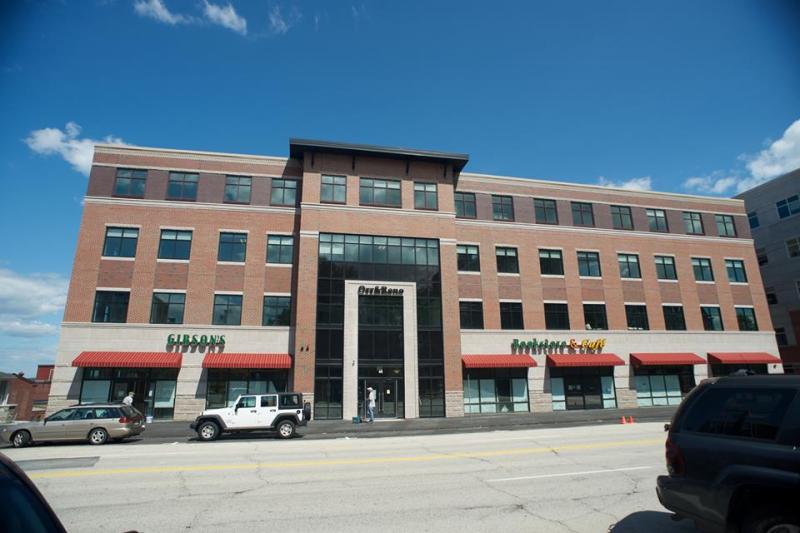- Categories:
On the Move: Booksellers Offer Insights on the Process of Relocating
A rite of passage for many bookstore owners and managers is a move of their bricks-and-mortar business into a new location. Here, offering their stories and advice for booksellers considering a move, are the owners of Gibson’s Bookstore, Mysterious Galaxy, and The Bookworm, all of whom have packed up, moved out, and set up in new spaces.
 Gibson’s Bookstore in Concord, New Hampshire, moved to a new, larger location in September 2013, just 200 yards away from the Main Street spot it had inhabited for 15 years. Following the closing of Borders in 2011, “we decided it was time to expand our store and our ambitions for bookselling,” said owner Michael Herrmann.
Gibson’s Bookstore in Concord, New Hampshire, moved to a new, larger location in September 2013, just 200 yards away from the Main Street spot it had inhabited for 15 years. Following the closing of Borders in 2011, “we decided it was time to expand our store and our ambitions for bookselling,” said owner Michael Herrmann.
Herrmann connected with a local developer who had plans for a new, four-story retail and office building and negotiated a lease for the ground floor. “We were looking for new construction and systems, and for cooperation and financial assistance in putting in the best features,” said Herrmann, and the developer agreed to build the space out to the bookstore’s specifications. “We negotiated a good lease with reasonable rent, performance-based adjustments, and an excellent fit-up allowance — all critical to our success.”

Because Gibson’s was moving to a bigger location, there was no need to decrease inventory, Herrmann said, but the store’s annual August sale did offer the opportunity to spread the word about the upcoming move. The store’s newsletter and social media postings also shared the news with customers, as did occasional articles in the local newspaper. “We also actively engaged customers by asking questions about what we should offer in our new store, now that we would have the space to expand operations,” said Herrmann.
Plans for the physical relocation of the store were very detailed and involved the help of a consultant. To carry out the move of books and fixtures, the store rented bookcases on wheels and hired a moving company. “Booksellers loaded the crates by section and in order, and the moving company took bookcases and books by truck and placed them according to a plan in our new space,” said Herrmann. The move was fast and headache-free, he added. “I definitely recommend hiring professionals for any move with even a hint of complexity.”

One of the difficult parts about the transition was closing the store for a week, said Herrmann. “But in hindsight, it was better to get everything right without trying to do business at the same time.”
Now in its larger space, the bookstore is doing well, despite some adjustments. “We are still ramping up to the kind of numbers we need to be doing to be a profitable store,” Herrmann noted, adding, “As the owner, I’m still on a learning curve as to how to manage a larger staff and larger costs.”
Herrmann recommended that booksellers considering a move think about it very carefully and identify what the motivations are behind a move, the vision for the store in five or 10 years, the pros and cons of the new location, and a fallback plan if goals aren’t met after the move. It’s also important to evaluate the support of the community and of the staff for such a move. “Ask yourself all these questions and crowdsource the answers; don’t try to puzzle them out yourself,” he said.
“If you decide to move, hire a professional consultant. After all, you only plan a new store once or twice in your lifetime — consultants do it for a living. Get professional advice and listen to it,” Herrmann added. “And finally, make sure you get a great deal from your new landlord. Remember, you are pretty much the ideal tenant.”
 Last December, after 15 years in the same location, San Diego’s Mysterious Galaxy reopened in a new shopping plaza two miles away. The move came as a result of a changing relationship with the bookstore’s landlord and the expansion of Mysterious Galaxy’s outside events business, which required a larger warehousing space, said co-owner Terry Gilman.
Last December, after 15 years in the same location, San Diego’s Mysterious Galaxy reopened in a new shopping plaza two miles away. The move came as a result of a changing relationship with the bookstore’s landlord and the expansion of Mysterious Galaxy’s outside events business, which required a larger warehousing space, said co-owner Terry Gilman.
The new storefront is 3,200 square feet, nearly twice the size of Mysterious Galaxy’s former location, but the space is quirky in that it’s hidden behind another building, so it was also the same price. “You literally can’t see it from any street,” Gilman said, but customers continue to show up following the move. “We’ve been in business for so long, people are willing to find us.”
The bookstore staff entered into the move with a detailed plan of action, which Gilman stressed as critical to the process. A to-do spreadsheet highlighted dates, staff names, and associated tasks, including the transfer of Internet and phone services, backup plans for processing credit cards through smartphones, insurance transitions, and staff training in the new space. A plan was also developed for packing up inventory, and a corresponding key identified how each section and box should be labeled to ease unpacking in the new store.

Gilman also saw the move as a unique opportunity to do a thorough physical inventory. “When we moved in, the inventory would be 100 percent correct, at least in theory,” she said. As the moving date approached, staff was packing up a section a day, logging inventory, and helping customers simultaneously. While these preparations were underway, Mysterious Galaxy’s buyer called publishers and sales reps to update the store’s address.
The move of the San Diego store into its new storefront followed the closure of Mysterious Galaxy’s Redondo Beach location in the summer of 2014. The owners had invested in brand-new fixtures for the Redondo Beach store, so Gilman contacted the original designer to have them repurposed for the new shop in San Diego. The bookshelves and fixtures were moved into the new location well before incorporating the inventory, which Gilman said made the move “considerably easier.” And, because Mysterious Galaxy’s busy season revolves around summer’s ComicCon, December proved to be an easy time to make the transition.
Following the move, business at Mysterious Galaxy is great, said Gilman, and the events program continues to grow. The local community was “incredibly interested in coming in and supporting us,” she said.
 Moving The Bookworm last October was a tough decision, said Beth Black, who owns the Omaha, Nebraska, bookstore with her husband, Phillip Black.
Moving The Bookworm last October was a tough decision, said Beth Black, who owns the Omaha, Nebraska, bookstore with her husband, Phillip Black.
Like a small town within a city, the Countryside Village Shopping Center that was home to The Bookworm from 1999 to 2014 is a square block area with a restaurant, grocery store, flower shop, bank, and other retailers, surrounded by residential neighborhoods, schools, and churches. “It was awesome because there was a really strong sense of community,” said Black. “It was the place to be.”
But when the new landlord’s rent proposal arrived with a 30 percent increase, The Bookworm could not stay, she said. “Moving was our only option. Anybody who’s in the book business knows that that kind of increase isn’t in books.” The Blacks made some phone calls to find out the going rate for comparable commercial spaces offering a favorable size, location, and neighborhood demographic and found a storefront in a nearby shopping center.
To inform publishers of the bookstore’s move, the Blacks relayed information through their sales reps, and the bookstore’s bookkeeper updated all their records. The owners are still working to update the many publicity contacts for each publisher to ensure galleys are sent to the right location.
 Getting the word out to customers about the move was the most difficult task, said Black. Notices about the move were shared via social media, the store website, and in-store signage. The Blacks also placed ads in area newspapers and secured local news coverage. The store’s website still features, in bright, bold lettering, information about the new location.
Getting the word out to customers about the move was the most difficult task, said Black. Notices about the move were shared via social media, the store website, and in-store signage. The Blacks also placed ads in area newspapers and secured local news coverage. The store’s website still features, in bright, bold lettering, information about the new location.
“As soon as it was announced, lots of people offered to help,” said Black, who left a sign-up sheet on the store counter for volunteers to leave their contact information. To make sure volunteers would show up when they were needed, an employee’s mother called everyone on the sign-up sheet to solidify their commitment.
“We had this whole contingent of volunteers to help us move. That was awesome, and very humbling, I might add,” Black said. “It showed how important a bookstore is to those people. It’s part of the community and part of who they are.”
Working within The Bookworm’s nearly 6,000 square feet of space, spread across two floors, dozens of volunteers boxed books or stacked them — in order — on carts, then handed them off to a local moving company the Blacks had hired. Fixtures were offered online for free to the first people to pick them up, and the store was emptied within six hours. “Everything, for the most part, went so smoothly,” said Black.
 Now settled in at Loveland Centre, Black said the store had strong sales over the holidays and has seen plenty of new shoppers. “We have been able to retain customers, but the number of people who are new just blows me away,” she said, crediting the surge of new faces to the more commercial location of the bookstore and the nearby colleges and hospitals. A restaurant that was located in The Bookworm’s old plaza has also since opened up at Loveland Centre, which has brought more of the bookstore’s old customers to the new spot. “This is home now,” said Black.
Now settled in at Loveland Centre, Black said the store had strong sales over the holidays and has seen plenty of new shoppers. “We have been able to retain customers, but the number of people who are new just blows me away,” she said, crediting the surge of new faces to the more commercial location of the bookstore and the nearby colleges and hospitals. A restaurant that was located in The Bookworm’s old plaza has also since opened up at Loveland Centre, which has brought more of the bookstore’s old customers to the new spot. “This is home now,” said Black.
Tips and tricks for planning a smooth move:
Gibson’s:
- Think about the move carefully. Ask yourself: What are you trying to accomplish? What are your motivations? How does a move fit in with your plans for five, 10, or 20 years from now? Have you done all your homework on the pluses and minuses of your proposed new location? What is your fallback plan if you don’t meet your goals in your new location? Do you have community support? Staff support?
- Hire a consultant to help with the planning: you only plan a new store once or twice in your lifetime — consultants do it for a living.
- Talk with customers about the move and get their perspectives on what to offer in the new space; involve them in the conversation.
- Negotiate a solid lease with reasonable rent that includes performance-based adjustments and a fit-up allowance — all critical for success.
- Use a professional moving company, rather than a bookstore brigade, if the move is complex.
Mysterious Galaxy:
- Prepare a detailed plan of action for the move, including a to-do spreadsheet highlighting dates, staff names, and associated tasks.
- Assign a staff member to oversee the transfer of Internet and telephone service; have a backup plan for processing credit cards through smartphones at the new location.
- Notify your insurance provider of the move.
- Develop a plan for staff training in the new space.
- Create a press release and share details about the move through social media, newsletters, and news outlets.
- Use the move as an opportunity to do a thorough physical inventory of the store.
- Create a key for labeling boxes and corresponding areas in the new store to ease unpacking.
- Arrange to have fixtures installed in the new location ahead of time, if possible, to make moving the inventory in easier.
The Bookworm:
- Find out the going rate for comparable commercial spaces that have a favorable size, location, and neighborhood demographic.
- Place ads in local newspapers and use social media to spread word about the move; keep the new information highly visible on your store website.
- Relay change-of-address details through publisher sales reps and have your bookkeeper update all records to reflect the move.
- Enlist volunteers by placing a sign-up sheet on the store’s counter following the announcement of the move; reach out to confirm volunteers’ willingness to help.
- Offer unneeded items, such as old fixtures, online for free to the first people who come to pick them up.

